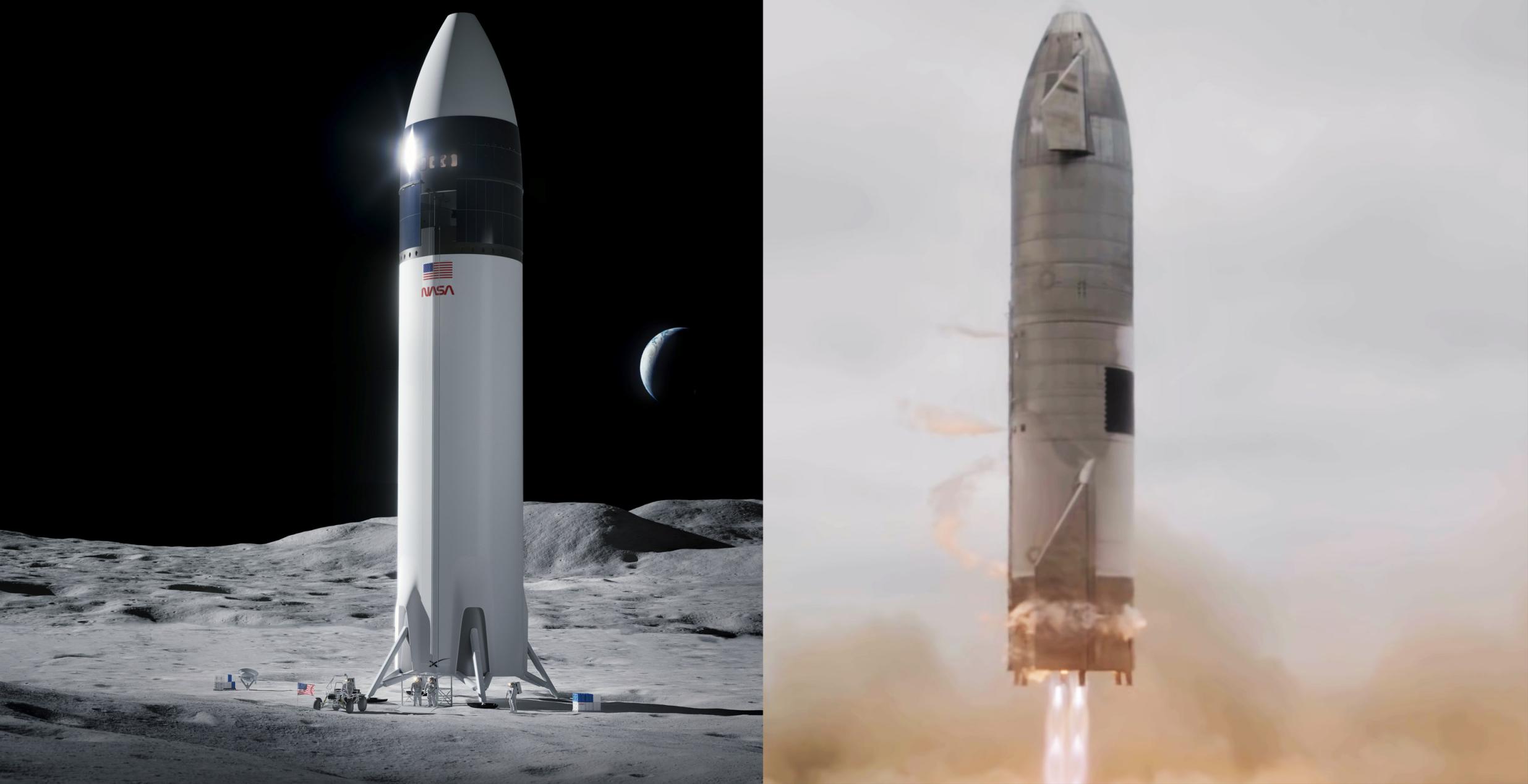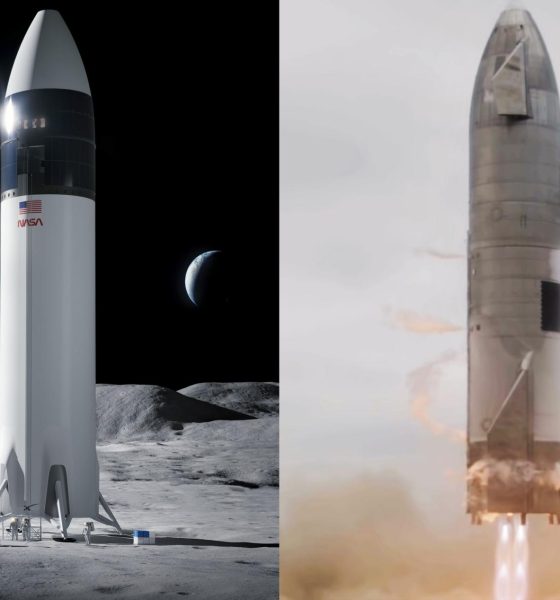

News
SpaceX and NASA defeat Blue Origin’s Starship Moon lander lawsuit
While specific details of the decision are likely a few weeks away, the US Court of Federal Claims has denied an infamous Blue Origin lawsuit, upholding NASA’s decision to award SpaceX a contract to create a Starship-derived Moon lander.
The ruling ends almost seven months of delays explicitly caused by protests and lawsuits filed by competitors Dynetics and Blue Origin. Protests were first filed with the US Government Accountability Office (GAO) about a week after NASA announced in April 2021 that SpaceX would build the Human Landing System. Both protests were denied in July but Blue Origin ultimately chose to double down and filed a lawsuit against NASA and SpaceX in August, kicking off a process guaranteed to cause several more months of delays.
NASA’s decision to contract with SpaceX alone defied most expectations, especially when the space agency ultimately explained that SpaceX’s Starship proposal was half the price of the next best option while simultaneously offering better management and more convincing technical expertise. More importantly, rather than attempting to deliver the bare minimum specifications NASA requested from HLS bidders, SpaceX’s Starship Moon lander went above and beyond, enabling potentially revolutionary performance magnitudes better than Blue Origin or Dynetics’ offerings.
Based on their redacted GAO protests, both of which contained a litany of frivolous arguments and dubiously relevant and self-unaware jabs at SpaceX, Blue Origin and Dynetics were furious about their losses. Aside from one minor nitpick, GAO wholly denied both protests, at which point Blue Origin took the matter to federal court rather than slink home, tail between its legs. In the interim between protest filing and GAO’s decision, Blue Origin also repeatedly tried to go behind NASA’s back by having sympathetic members of Congress tack on amendments to unrelated bills that would have forced the space agency to select a second HLS lander without guaranteeing the additional funding needed to pay for it.
Blue Origin owner and former Amazon CEO Jeff Bezos even sent an unsolicited letter and proposal to NASA offering to pony up $2B of the ~$6B it requested to develop a NASA Moon lander. SpaceX, on the other hand, did what NASA’s HLS request for proposal (RFP) explicitly asked of bidders and proposed to pay half of its Starship lander development costs in its original proposal, while Blue Origin instead attempted to milk as much money from NASA as possible under the delusional premise that NASA would then negotiate for a cheaper deal (illegal under basic contracting rules).
Later on, weeks into the lawsuit, redacted court filings revealed that Blue Origin had abandoned most of the arguments it put forth in its GAO protest and was instead leading with the claim that a few minor (but potentially valid) violations of contracting rules made by NASA and SpaceX in their limited post-award negotiations. It’s now clear that the presiding judge was far from convinced by that argument, instead ruling entirely in SpaceX and NASA’s favor and upholding the space agency’s HLS procurement process.
It remains to be seen if the judge was at all swayed by any of the several arguments Blue Origin threw at the wall, something that the court’s final redacted decision will hopefully clarify when it’s released around November 18th. In the meantime, it’s unclear when exactly NASA and SpaceX will be able to finally get back to work on HLS. Prior to the court’s decision, NASA’s voluntary stay of performance – preventing collaboration with SpaceX on its HLS contract – was scheduled to expire on November 8th.
The brief decisions can be read here (PDF) and here (PDF).

Elon Musk
Elon Musk’s X will start using a Tesla-like software update strategy
The initiative seems designed to accelerate updates to the social media platform, while maintaining maximum transparency.

Elon Musk’s social media platform X will adopt a Tesla-esque approach to software updates for its algorithm.
The initiative seems designed to accelerate updates to the social media platform, while maintaining maximum transparency.
X’s updates to its updates
As per Musk in a post on X, the social media company will be making a new algorithm to determine what organic and advertising posts are recommended to users. These updates would then be repeated every four weeks.
“We will make the new 𝕏 algorithm, including all code used to determine what organic and advertising posts are recommended to users, open source in 7 days. This will be repeated every 4 weeks, with comprehensive developer notes, to help you understand what changed,” Musk wrote in his post.
The initiative somewhat mirrors Tesla’s over-the-air update model, where vehicle software is regularly refined and pushed to users with detailed release notes. This should allow users to better understand the details of X’s every update and foster a healthy feedback loop for the social media platform.
xAI and X
X, formerly Twitter, has been acquired by Elon Musk’s artificial intelligence startup, xAI last year. Since then, xAI has seen a rapid rise in valuation. Following the company’s the company’s upsized $20 billion Series E funding round, estimates now suggest that xAI is worth tens about $230 to $235 billion. That’s several times larger than Tesla when Elon Musk received his controversial 2018 CEO Performance Award.
As per xAI, the Series E funding round attracted a diverse group of investors, including Valor Equity Partners, Stepstone Group, Fidelity Management & Research Company, Qatar Investment Authority, MGX, and Baron Capital Group, among others. Strategic partners NVIDIA and Cisco Investments also continued support for building the world’s largest GPU clusters.
News
Tesla FSD Supervised wins MotorTrend’s Best Driver Assistance Award
The decision marks a notable reversal for the publication from prior years, with judges citing major real-world improvements that pushed Tesla’s latest FSD software ahead of every competing ADAS system.

Tesla’s Full Self-Driving (Supervised) system has been named the best driver-assistance technology on the market, earning top honors at the 2026 MotorTrend Best Tech Awards.
The decision marks a notable reversal for the publication from prior years, with judges citing major real-world improvements that pushed Tesla’s latest FSD software ahead of every competing ADAS system. And it wasn’t even close.
MotorTrend reverses course
MotorTrend awarded Tesla FSD (Supervised) its 2026 Best Tech Driver Assistance title after extensive testing of the latest v14 software. The publication acknowledged that it had previously criticized earlier versions of FSD for erratic behavior and near-miss incidents, ultimately favoring rivals such as GM’s Super Cruise in earlier evaluations.
According to MotorTrend, the newest iteration of FSD resolved many of those shortcomings. Testers said v14 showed far smoother behavior in complex urban scenarios, including unprotected left turns, traffic circles, emergency vehicles, and dense city streets. While the system still requires constant driver supervision, judges concluded that no other advanced driver-assistance system currently matches its breadth of capability.
Unlike rival systems that rely on combinations of cameras, radar, lidar, and mapped highways, Tesla’s FSD operates using a camera-only approach and is capable of driving on city streets, rural roads, and freeways. MotorTrend stated that pure utility, the ability to handle nearly all road types, ultimately separated FSD from competitors like Ford BlueCruise, GM Super Cruise, and BMW’s Highway Assistant.
High cost and high capability
MotorTrend also addressed FSD’s pricing, which remains significantly higher than rival systems. Tesla currently charges $8,000 for a one-time purchase or $99 per month for a subscription, compared with far lower upfront and subscription costs from other automakers. The publication noted that the premium is justified given FSD’s unmatched scope and continuous software evolution.
Safety remained a central focus of the evaluation. While testers reported collision-free operation over thousands of miles, they noted ongoing concerns around FSD’s configurable driving modes, including options that allow aggressive driving and speeds beyond posted limits. MotorTrend emphasized that, like all Level 2 systems, FSD still depends on a fully attentive human driver at all times.
Despite those caveats, the publication concluded that Tesla’s rapid software progress fundamentally reshaped the competitive landscape. For drivers seeking the most capable hands-on driver-assistance system available today, MotorTrend concluded Tesla FSD (Supervised) now stands alone at the top.
News
Elon Musk’s Grokipedia surges to 5.6M articles, almost 79% of English Wikipedia
The explosive growth marks a major milestone for the AI-powered online encyclopedia, which was launched by Elon Musk’s xAI just months ago.

Elon Musk’s Grokipedia has grown to an impressive 5,615,201 articles as of today, closing in on 79% of the English Wikipedia’s current total of 7,119,376 articles.
The explosive growth marks a major milestone for the AI-powered online encyclopedia, which was launched by Elon Musk’s xAI just months ago. Needless to say, it would only be a matter of time before Grokipedia exceeds English Wikipedia in sheer volume.
Grokipedia’s rapid growth
xAI’s vision for Grokipedia emphasizes neutrality, while Grok’s reasoning capabilities allow for fast drafting and fact-checking. When Elon Musk announced the initiative in late September 2025, he noted that Grokipedia would be an improvement to Wikipedia because it would be designed to avoid bias.
At the time, Musk noted that Grokipedia “is a necessary step towards the xAI goal of understanding the Universe.”
Grokipedia was launched in late October, and while xAI was careful to list it only as Version 0.1 at the time, the online encyclopedia immediately earned praise. Wikipedia co-founder Larry Sanger highlighted the project’s innovative approach, noting how it leverages AI to fill knowledge gaps and enable rapid updates. Netizens also observed how Grokipedia tends to present articles in a more objective manner compared to Wikipedia, which is edited by humans.
Elon Musk’s ambitious plans
With 5,615,201 total articles, Grokipedia has now grown to almost 79% of English Wikipedia’s article base. This is incredibly quick, though Grokipedia remains text-only for now. xAI, for its part, has now updated the online encyclopedia’s iteration to v0.2.
Elon Musk has shared bold ideas for Grokipedia, including sending a record of the entire knowledge base to space as part of xAI’s mission to preserve and expand human understanding. At some point, Musk stated that Grokipedia will be renamed to Encyclopedia Galactica, and it will be sent to the cosmos.
“When Grokipedia is good enough (long way to go), we will change the name to Encyclopedia Galactica. It will be an open source distillation of all knowledge, including audio, images and video. Join xAI to help build the sci-fi version of the Library of Alexandria!” Musk wrote, adding in a later post that “Copies will be etched in stone and sent to the Moon, Mars and beyond. This time, it will not be lost.”








